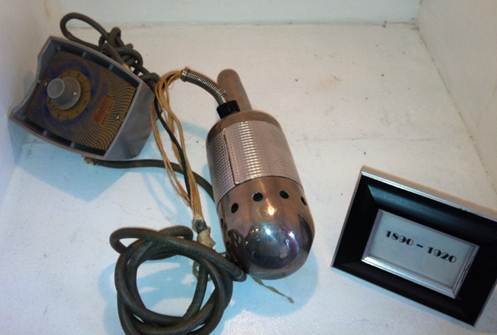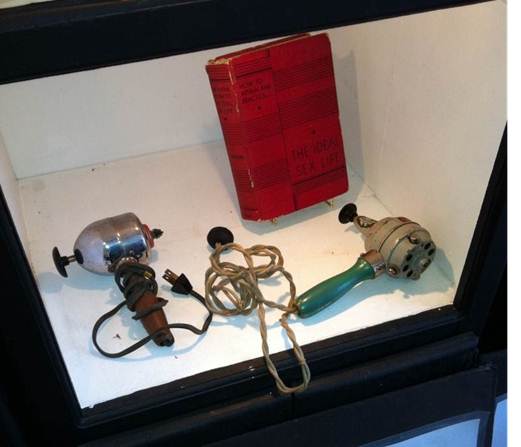The History Of Motorized Sex Toys
August 8, 2012 by Justin Lehmiller
9/18/2018 Editor’s Note and Disclaimer: This 2012 blog post was based largely on claims made in the book The Technology of Orgasm by Rachel Maines. Many of the claims made in this book were called into question in 2018 in a paper published in the Journal of Positive Sexuality, which I blogged about here.
Believe it or not, human beings have been making sex toys since the Stone Age. Dildos, Ben Wa balls, and various other devices to aid in sexual pleasure have a surprisingly long (and quite interesting) history. However, out of all of the different sex toys that have ever been created, one in particular stands out for having a most unique and “hysterical” backstory: the vibrator. In this post, I will not only share the origin of motorized sex toys, but I will also take you on a tour of some of the latest “pocket rockets.”
In the modern world, vibrators are a sex and masturbation aide utilized by both men and women alike. However, were originally popularized as a therapeutic device for doctors to use on female patients who were diagnosed with hysteria, a medical condition that has long since been debunked. At one point in time, hysteria was among the most common medical disorders diagnosed in women and included a wide range of symptoms from nervousness and insomnia, to loss of appetite for sex with one’s husband, to a “tendency to cause trouble for others” [1]. Looking back on it, the symptoms were actually so broad and so general that almost any woman with any medical complaint could be diagnosed as hysterical. Although hysteria was originally thought to be the result of a woman’s uterus “wandering” throughout her body and causing problems, later physicians viewed the disorder as a consequence of inadequate or insufficient sex.
For centuries, the primary treatment for hysteria was a “pelvic massage” that culminated in “hysterical paroxysm” (i.e., orgasm) [1]. Massages of this nature were usually performed by doctors, who made a hefty profit practicing this “therapy,” given that hysteria was so prevalent and, of course, required multiple treatments. In reality, all these doctors were actually doing was giving women the orgasms that their husbands didn’t (or couldn’t) and taking the husbands’ money for the privilege of doing so!
The only problem for doctors was that these treatments became rather tedious because it can take some women a long time to reach orgasm (even with effective stimulation, it can take an average woman up to 20 minutes) and the doctors were doing it all by hand. The first vibrator was thus invented as a way of cutting down on the length of office visits, thereby allowing doctors to “treat” more patients.
However, as electricity started making its way into people’s homes, the consumer market for vibrators grew rapidly. Not only could a personal vibrator save a lot of money on trips to the doctor’s office, but it could also be utilized within the privacy of one’s own home day or night. The demand for vibrators was actually so strong that motorized sex toys became just the fifth electric device approved for home use after the sewing machine, fan, teakettle, and toaster [1 ]. Vibrators thus made their way into homes long before vacuum cleaners, electric irons, and television sets.
On a side, note, those early vibrators looked a little frightening if you ask me. Here are a couple of photos I took of some late 19th and early 20th century vibrators I saw on display at a sex museum.


I don’t know about you, but I have a hard time imagining anyone wanting to voluntarily put those devices anywhere near their genitals! Fortunately, times have changed and sexual technology has advanced considerably. For one thing, modern vibrators are now battery operated (or solar powered, for the environmentally conscious) and many are waterproof, so there’s far less risk of electrocution. But beyond that, there are now vibrators available to serve many different sexual purposes, with some designed for women, and some for men. Certain vibrators are optimized for stimulation of the clitoris, others for the G-spot, and yet others for the anus. Some vibrators are lifelike, others are pointy and ribbed, and some look kind of like probes taken from an alien spaceship. And, of course, vibrators now come in all different sizes, shapes, and colors.
As you can see, the history and evolution of vibrators is a fascinating subject. If you want to know more about this topic, I recommend checking out The Technology of Orgasm. It’s one of my personal favorites and makes for a great summer read!
Want to learn more about Sex and Psychology? Click here for more from the blog or here to listen to the podcast. Follow Sex and Psychology on Facebook, Twitter (@JustinLehmiller), or Reddit to receive updates. You can also follow Dr. Lehmiller on YouTube and Instagram.
[1] Maines, R. P. (1998). The Technology of Orgasm: “Hysteria”, the Vibrator, and Women’s Sexual Satisfaction. Baltimore, MD: The Johns Hopkins University Press.
Image Source: iStockphoto
You Might Also Like:

Dr. Justin Lehmiller
Founder & Owner of Sex and PsychologyDr. Justin Lehmiller is a social psychologist and Research Fellow at The Kinsey Institute. He runs the Sex and Psychology blog and podcast and is author of the popular book Tell Me What You Want. Dr. Lehmiller is an award-winning educator, and a prolific researcher who has published more than 50 academic works.
Read full bio >


